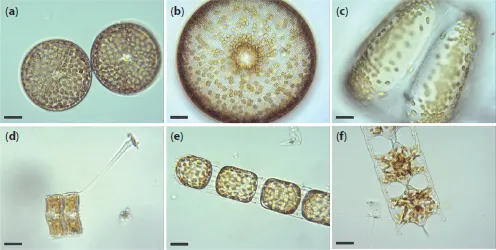
Diatom Morphogenesis
Vadim V. Annenkov, Joseph Seckbach, Richard Gordon, Vadim V. Annenkov, Joseph Seckbach, Richard Gordon
- English
- ePUB (adapté aux mobiles)
- Disponible sur iOS et Android
Diatom Morphogenesis
Vadim V. Annenkov, Joseph Seckbach, Richard Gordon, Vadim V. Annenkov, Joseph Seckbach, Richard Gordon
À propos de ce livre
DIATOM MORPHOGENESIS
A unique book presenting the range of silica structures formed by diatoms, theories and hypotheses of how they are made, and applications to nanotechnology by use or imitation of diatom morphogenesis.
There are up to 200, 000 species of diatoms, each species of these algal cells bearing an ornate, amorphous silica glass shell. The silica is structured at 7 orders of magnitude size range and is thus the most complex multiscalar solid structure known. Recent research is beginning to unravel how a single cell marshals chemical, physical, biochemical, genetic, and cytoskeletal processes to produce these single-cell marvels. The field of diatom nanotechnology is advancing as this understanding matures.
Diatoms have been actively studied over the recent 10-20 years with various modern equipment, experimental and computer simulation approaches, including molecular biology, fluorescence-based methods, electron, confocal, and AFM microscopy. This has resulted in a huge amount of information but the key stages of their silica morphogenesis are still not clear. This is the time to reconsider and consolidate the work performed so far and to understand how we can go ahead.
The main objective of this book is to describe the actual situation in the science of diatom morphogenesis, to specify the most important unresolved questions, and to present the corresponding hypotheses. The following areas are discussed:
- A tutorial chapter, with a glossary for newcomers to the field, who are often from outside of biology, let alone phycology;
- Diatom Morphogenesis: general issues, including symmetry and size issues;
- Diatom Morphogenesis: simulation, including analytical and numerical methods for description of the diatom valve shape and pore structure;
- Diatom Morphogenesis: physiology, biochemistry, and applications, including the relationship between taxonomy and physiology, biosilicification hypotheses, and ideas about applications of diatoms.
Audience
Researchers, scientists, and graduate students in the fields of phycology, general biology, marine sciences, the chemistry of silica, materials science, and ecology.
Foire aux questions
Informations
Part 1
GENERAL ISSUES
1
Introduction for a Tutorial on Diatom Morphology
AbstractDiatoms are an exceptionally successful group of unicellular microalgae with a large contribution of global primary production in aquatic environments and contributing a significant amount of oxygen to both hydro- and atmospheres. They are fascinating throughout their life and even after death, thanks to their unique cell walls made from ornamented silica. The diatoms include centric species, which may have radial or polar symmetry, and pennates, which include araphid, monoraphid, and biraphid species. Several applications have utilized diatomite, i.e., the fossil form of diatom frustules. To date, many diatoms’ secrets have been understood; however, there are still more hidden. Thus, there is a need for more research on diatom basic biology and applications. Seeking this goal, more people should be encouraged to work on diatoms. Often novice researchers are overwhelmed by the terminology associated with the diverse morphology, the discrepancy between expected features for published descriptions, and the actual observation of those complex 3D organisms, which can be a barrier for more progress. Here, we provide a brief introduction to the beginners with a guide to approach the complex diatom morphology focusing on the tools that can be used for its study.Keywords: Diatom morphology, tutorial, LM and SEM, frustule morphology
1.1 Diatoms in Brief
